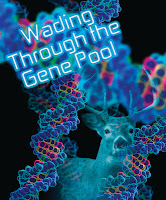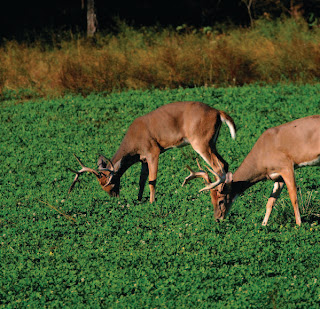Back in the 1980s, my cousins and I decided to “get serious” about
improving the buck quality on the 600-plus acres we hunted in central
Wisconsin. Most of us were not far removed from a farm background, so one of
the first things we did was something any good farmer who wanted his critters
to grow big and impressive would do: We tried to get rid of breeding age males
that looked inferior. We’d have had more success herding cats.
At first glance, shooting sub-par bucks
— a practice known as “culling” — makes perfect sense. Why let scrawny, poorly
antlered males contribute their genes to the annual fawn crop, especially when
there are — or should be — true stud horses willing to take their place? Eliminating
less-desirable males from the gene pool is standard operating procedure in
everything from hunting dogs to race horses. Why would it not work with deer?
Especially when we knew that the whitetail breeding process was based on a
dominance-based hierarchy that favored the biggest, strongest and oldest bucks.
By shooting scraggly inferiors, we’d enjoy a super-race of sleek bucks bound
for the B&C books in a few seasons. Well that fantasy sure didn’t match
reality, at least the one we lived in in our corner of Wisconsin. And now —
many years later — we know why. Research projects have shined a huge, beaming
light on the mechanics of the whitetail breeding process, and taught us exactly
why culling bucks in free-ranging herds is most often simply bad science. What
follows is a brief summary of each project and its implications for managers.
WHAT’S
IN AN ANTLER?
Culling, of
course, relies on taking out those bucks that lack “the right stuff” to produce
mega-antlers. And what is the most obvious indicator of which bucks make the
cut and which bite the dust? Why, antlers of course. You don’t have to have
been around deer hunting long before you hear the age-old theory that spike
bucks are inferior to their branch-antlered brothers and cousins. And in some
cases, that old saw might be true. But in most others, it’s simply dead wrong.
Research has proven that some young bucks just get off to a rough start often
because they were born a little later, or good antler-growing conditions just
didn’t exist that year. But they can blossom into trophies if given time and a
chance and are provided proper nutrition.
Another category of cull bucks are
those with deformed or misshapen antlers. We’ve all seen these goofy-looking
abnormals trotting through the timber — tines stubbed off; main beams blunted
or curved oddly; and even bucks that pack a classic, gorgeous right or left
side can have a matching antler that is nothing more than a pathetic spike,
fork or twisted-up main beam. These were the bucks my cousins and I liked to
kill when we were culling.
“Never amount to anything, anyway,”
we’d say as we showed our group another yearling buck done in before his prime.
Although some bucks will indeed carry deformed
— or at least non-classic — antlers their entire lives, there’s just as strong
a chance that an unbalanced rack will correct itself in the future. Injuries to
the antlers or the opposing rear quarter can damage antlers one season and then
be a non-factor the next. Noted researcher Mickey Hellickson proved this with a
telemetry buck they captured in one of his King Ranch studies. At the year of
capture, the buck was a 3-1/2-year old, with six tines on one side and an ugly
fork on the other. The next year the buck was a gorgeous 7-by-6 that Hellickson
wouldn’t have recognized had it not been a study animal with an imbedded
microchip. Two years later, as a 6-1/2-year-old, the buck sported an even
larger 13-point rack with four sticker points that grossed nearly 180 inches.
CONTROLLED
BREEDING?
Another long-held belief about the
whitetail rut is that the biggest, oldest, most dominant bucks monopolized much
of the breeding. More King Ranch research — led again by Hellickson — proved
this is not true. The King Ranch, remember, is perhaps the most intensely
managed whitetail population in America. Buck-to doe ratios are as close to
ideal as possible, and there are a good number of bucks spread across all age
classes; up to 30 percent of the bucks are 5-1/2-years-old or older. (Sound
like your property? Mine neither). Even with big, old, deer present, immature
bucks — 2-1/2 or younger — sired 35 percent of all fawns. Researchers proved
this by matching DNA from captured deer and identifying the lineage for each
animal. It gets even more interesting. Although old, massive-racked bucks are
the intended goal of many management programs, Hellickson’s research proved
that some mature bucks simply don’t participate much in the rut.
“We had 7-1/2-year-old bucks that bred
hard for only one season, and some bucks just didn’t get into breeding at all,”
he said. “We don’t know if that’s a personality thing — some bucks are simply
shy and reclusive — or a function of dominance or something else. All we
learned for sure is that it’s almost impossible to predict the breeders,
regardless of size or age.”
But recent research — at the King Ranch
and other places — has also proven another interesting statistic: Individual
bucks tend to only a handful of does each fall. And of the fawns they actually
sire, a percentage will succumb to predation or accidents. This makes the
actual contribution of even a highly desired “breeder” buck to the area deer
herd a statistical drop-in the- bucket. Of course, it’s great when a studly, towering-antlered
giant passes his superior genetic traits down to a young buck fawn. But any
manager of a free-ranging deer herd who thinks he can make that happen with
regularity is kidding himself.
And finally there’s this: Hunters have
long had a tunnel vision that focused solely on the contribution that a buck
makes to a fawn’s genetic makeup, but even the greenest farmer can tell you
that the female half of the equation is equally important. And how are we to
select for the most genetically superior does in a wild population? Body size?
Ear length? Tail diameter? I’m being facetious here, of course. We have no such
control and likely never will. Managers of wild deer do not live in a world of
penned does, semen straws and artificial insemination. Our attempts to
influence the genetic makeup of our whitetails might be admirable but are largely
futile.
SO NOW WHAT?
Faced with such
statistics, it might be tempting to throw our collective hands up in the air and
wonder why the heck we try so hard to grow quality deer. The key, of course, is
to focus on factors we can control, and forget the ones where nature is driving
the car.
In other words, let captive breeders
worry about genetics. They have some measure of control in that arena, but wild
deer managers do not. Indeed, free-ranging deer actually benefit from genetic
diversity, which is at least one of nature’s reasons for making yearling bucks
disperse to areas far from their home range. I’m sure a biologist could list
other ways in which deer populations are saved from in-breeding, but I’m not
that guy. All I know is, fretting about genetics is not only a monumental waste
of time, but it takes us a scary step closer toward thinking of whitetails as
domestic animals that we “raise” or “grow.” In my opinion, waltzing down that
road is a sad step, if not a dangerous one.
So what do we do? We make the habitat
we own or manage as good as it can possibly be, and then let whitetails do the
rest. Providing quality food plots is a huge part of the equation, as well as a
never-ending challenge. I have the privilege of talking to many deer hunters
each year, and the popularity of food-plotting is only matched by the questions
that wanna-be farmers (like me) have after dipping their toes in that pool. But
whether we’re struggling to grow that perfect stand of Imperial Whitetail
Clover or fretting whether we should experiment with Imperial Winter-Greens, we
know that we’re helping whitetails be as healthy as possible.
Managing timber and other forms of
whitetail cover is a second, though no-less-vital link to managing a deer herd.
Whitetails are largely a woodland species — one that thrives in young growth timber
that provides browse and cover for bedding, security and fawning. Food plots are
understandably a hot item right now, but let’s never forget that timber
management — as well as the creation and management of grass-lands, river
corridors, wetlands and other critical habitat — is every bit as vital to deer.
Maintain ideal cover, I’m convinced, and we’ll be able to grow all the mature
bucks our property is capable of producing.
Third, if we really want to improve the
composition and age structure of our herd, we’ll make the right decisions about
which — and how many — deer we kill. I’m still amazed at the number of hunters
who tell me, “I want as many does on my ground as possible, so then I know
where all the bucks will be during the rut.” Well I’ve never lived in that
world, but I have a couple of very good friends who had “as many does on their
ground as possible.” Though their properties held good bucks, killing one was
nearly impossible during the rut, as mature deer barely had to move to find a
willing doe. And though many bucks survived to old age, very few ever grew great
antlers. Stressed from a long and arduous rut, the bucks barely scraped through
winter, competing for food with oodles of does. Only when an aggressive
doe-harvest plan, designed to bring overall deer numbers in tune with the
habitat, was implemented did the bucks start growing to their potential. Even
better, they became more killable.
Finally, celebrate the success of
taking a buck from the bounty now and then. I’ve known hunters who tag a fine,
mature whitetail but then second guess their decision by wondering, “Maybe I
should have left him to breed another year or grow bigger.” If the buck trips
your trigger when you see him in the field, and he meets the harvest criteria
for that property, shoot the buck, and count it as a marker of success. Passing
a deer to see if he’ll gain 20 inches the next fall is understandable, as long
as it doesn’t get out of hand and raise the harvest bar so high nearly every
buck is off limits. (I’ve seen this happen, too).
But passing on a buck because one more
year of breeding will somehow benefit the area’s genetics? This is as foolhardy
as turning down a date with the pretty girl next door in hopes that Angelina
Jolie will show up and whisk you off your feet.
Growing great food plots. Implementing
a long-term, well-designed, habitat management plan. Keeping deer numbers in
tune with property size and available habitat. All are time-consuming,
difficult and worthy goals to strive for.
But controlling or improving genetics? You
might as well try herding cats.

